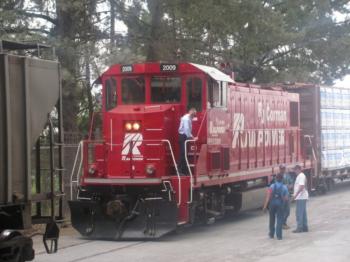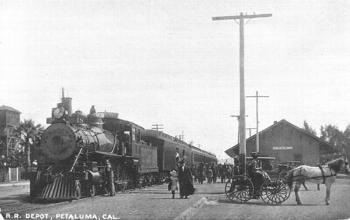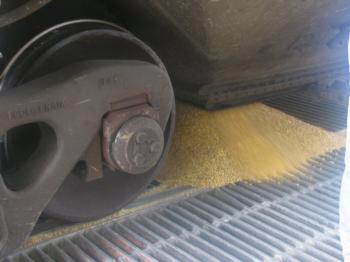Agriculture rides the rails again

Rail freight is up and running after a 10-year dormancy. Starting on July 13, 2011 the Northwestern Pacific Railroad Company, known as “NWP Co.”, began service on the 62 miles of track from American Canyon to Windsor. This includes the re-installment of deliveries to feed mills in Petaluma. And the service is growing. John William, President of NWP, explained that “we started with zero car loads a year ago and now are delivering 100 rail cars a month.” Each one of those cars carries up to 110 tons of grain.

Rail service and local agriculture have a long mutually supportive relationship. Adair Heig writes in her book History of Petaluma: A California River Town that “San Francisco and North Pacific stopped in east Petaluma and picked up freight and passengers at the depot built in 1871 on Hopper Street.” By 1879 tracks and depots connected Sausalito, San Rafael, Novato and the rest of Marin County with the rail network in Sonoma and the north coast. This transportation system was critical for making livestock feed available at affordable prices to Marin and Sonoma’s poultry and dairy producers, and instrumental in distributing their agricultural products around the country.

What do these savings mean for the farmer and rancher? “There is real savings in transportation that benefits us,” offered George McClelland of McClelland’s Dairy. “Because I don’t want to compromise on quality,” Arnie Riebli expressed he can also transfer the savings in transportation into maintaining grain quality through purchasing the best quality he can find for his members. Local dairymen Jim McIsaac explained “these cost savings help us,” adding, “feed prices are so high any savings is a help.”
Indeed, these are not good times for grain prices. The protracted and wide spread drought in the Midwest along with other fuel policies are severely limiting supply and driving prices to record highs. “I don’t want to even tell you my grain bill, it’s obscene,” shared John Taylor of Bianchini Ranch. Similarly Steve Mahrt, owner of Petaluma Farms, characterized current farming balance sheet as a “slow bleed” because of grain prices. “Corn and other grains are at the highest they have been in decades” confirmed Arnie Riebli.
Reducing costs is not the only benefit that rail freight is providing, however. There are reductions in fuel consumption and traffic. Currently NWP Co. is making two trips a week of 10 to 15 cars each. A rail car is equal to four large trucks or 40 to 60 trucks per trip. This translates to between 400 and 500 fewer truck trips per month. Rail freight can transport one ton of merchandise 480 miles per gallon of gas as documented by the Association of American Railroads. Compare this to 110 miles per gallon of gas for the same ton transported by truck and the savings add up.
Another benefit of the rail is its connection to feed sources only available through train transportation. This provides “versatility” explains Arnie Riebli. Echoing this, George McClelland related, “I have been able to source feed from more markets,” increasing his adaptability.
With these benefits being brought to the region, what does the future hold for the rail and agricultural relationship? Arnie Riebli described the interdependency of the relationship going forward when he shared “as much as we depend upon rail, rail depends upon us.” John Williams sees the opportunity to complete the circle, with agricultural products from Marin and the North Bay going out on rail. “We are currently discussing beer and wine transport,” Williams offered, adding “cheese is shipped on rail from the California’s Central Valley and Oregon, and we are ready to talk about doing the same here.” Other opportunities include materials transport for value-added products. Albert Straus, President of Straus Family Creamery, shared “we are looking for the day when rail can bring bottles and cartons that we use for packaging.” Summing his aspirations for rail going forward, Robert Falco stated “we hope it is here to stay for a long time.”
By David Lewis



